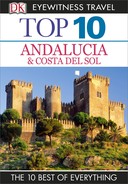Andalucian Souvenirs
1. Granada Pottery
Andalucía’s most famous pottery celebrates the symbol of Granada, the pomegranate, and is glazed in turquoise and cobalt blue over white.
2. Granada Taracea
Granada’s Moorish-inspired marquetry uses bone, mother-of-pearl, amber and marble in the finest inlays, although humbler objects employ coloured wood chips. You’ll find chessboards, tables and boxes of all sizes.
3. Moroccan Crafts
The Albaicín area of Granada (for further details see Moorish Granada: Albaicín) has become a mini-Morocco. Here you can buy leather slippers, embroidered robes, silver tea services and decorative ceramics.
4. Flamenco and Traditional Accessories
If you plan on attending a romería or any other local festival – or you just feel like taking home a bit of local colour – consider investing in some traditional flamenco paraphernalia. Embroidered silk shawls, ornate tortoiseshell combs and hand-painted silk and ivory fans are the top of the line, but there are plenty of more affordable versions. Synthetic shawls, these days often imported from China, wood or even plastic combs and paper and wood fans are all just as vivid.
5. Silver and Gold Filigree
Two cities, Córdoba and Granada, are known for their delicate filigree work in precious metals. Since ancient times, when Andalucían mines were a primary source of silver and gold for the Mediterranean, craftsmen have created brooches, earrings and necklaces. Designs often reflect the Moorish taste for complex geometrics, but can also depict insects, birds or lizards, set with precious stones.
6. Woodwork
Furniture manufacture of high-quality mahogany items takes place in Cádiz Province, while Ronda is known for its rustic styles and Granada Province is reputed for Mudéjar (Capiliera) and Renaissance (Baza) styles. Also of note, of course, are Andalucían guitars, with excellent examples created in Algodonales (Cádiz Province) and Marmolejo (Jaén Province), as well as in the main centres of Granada, Córdoba and Seville.
7. Iron and Metalwork
Wrought-iron and other metal pieces that might tempt you include tin lamps from Úbeda, grilles from Arcos de la Frontera and Torredonjimeno, cowbells from Cortegana and locks from Estepona and Cártama.
8. Leather
Leather goods of all sorts abound. Principal towns of production include Jerez de la Frontera, Almodóvar del Río, Almonte and Ubrique for bags, belts, gloves and jackets. For handmade shoes try Montoro; for handmade boots, Valverde del Camino, both in Huelva Province. Most traditional are cordovans – embossed and hand-decorated leather pieces from Córdoba.
9. Ceramics
Ceramics come in almost as many styles and forms as there are towns – items as diverse as traditional azulejos (glazed tiles), botijos (double-spouted pitchers) and Hispano-Moorish lustreware. Most tend towards the Islamic style but many carry on the European tradition of depicting scenes from daily life or myths.
10. Weavings
The various weaving arts are well represented in Andalucía. Wickerwork and basketry are notable in Almería, Níjar, Jerez, Lanjarón and Jaén. Jarapas (handwoven rugs and blankets) are famous in Almería Province, as well as in Arcos de la Frontera, Grazalema in Cádiz Province, and Las Alpujarras in Jaén Province.
